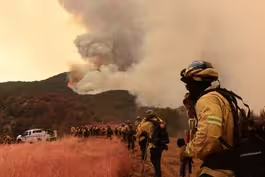
Climate and market factors drive beef prices to record highs
Clip: 8/19/2025 | 7m 36sVideo has Closed Captions
The climate and market factors driving beef prices to record highs
Beef prices have soared to all-time highs with many families feeling the squeeze. Economics correspondent Paul Solman looks at the factors driving prices higher.
Problems playing video? | Closed Captioning Feedback
Problems playing video? | Closed Captioning Feedback
Major corporate funding for the PBS News Hour is provided by BDO, BNSF, Consumer Cellular, American Cruise Lines, and Raymond James. Funding for the PBS NewsHour Weekend is provided by...

Climate and market factors drive beef prices to record highs
Clip: 8/19/2025 | 7m 36sVideo has Closed Captions
Beef prices have soared to all-time highs with many families feeling the squeeze. Economics correspondent Paul Solman looks at the factors driving prices higher.
Problems playing video? | Closed Captioning Feedback
How to Watch PBS News Hour
PBS News Hour is available to stream on pbs.org and the free PBS App, available on iPhone, Apple TV, Android TV, Android smartphones, Amazon Fire TV, Amazon Fire Tablet, Roku, Samsung Smart TV, and Vizio.
Providing Support for PBS.org
Learn Moreabout PBS online sponsorshipGEOFF BENNETT: Beef prices have soared to all-time highs, with many families feeling the squeeze.
Economics correspondent Paul Solman looks at the factors driving prices higher.
PAUL SOLMAN: Got a beef with beef prices?
You have got company.
JANET SMITH, Shopper: I was looking at the price of a pound of ground beef and three months ago, it was $4.99 a pound.
And a week ago Saturday, it was $7.99 a pound.
PAUL SOLMAN: And it is not just beef.
WOMAN: It seems lately like every time I go into the store, I have sticker shock.
It's alarming to me.
I'm almost afraid to go in there, what I'm going to find.
PAUL SOLMAN: Almost 90 percent of Americans now say they're stressed about grocery prices, which have been up for three main reasons.
PHIL LEMPERT, SupermarketGuru: Because of tariffs, because of weather and climate conditions, because of the labor costs.
PAUL SOLMAN: And shoppers have been paying more for a number of years.
PHIL LEMPERT: Since the pandemic, food prices are up over 26 percent.
So we're having sticker shock every time we go to that cash register.
PAUL SOLMAN: Official grocery prices actually dipped slightly last month.
But one food that keeps climbing on a monthly and yearly basis is beef.
Ground beef is up 11.5 percent since just last year.
PHIL LEMPERT: Ground beef is the highest price that it's ever been.
CPI data started being collected in the 1980s.
This is the first time it's over $6 a pound.
And when we look at beef and veal prices, they're up over 10 percent.
PAUL SOLMAN: As of July, beef and veal were up 11.3 percent over the last 12 months.
Why?
DAVID ANDERSON, Texas A&M University: It's kind of the age-old economist answer, supply and demand.
We're producing less beef.
At the same time, consumers are demanding beef.
We really have had growing demand for beef for a decade.
ACTRESS: Where's the beef?
PAUL SOLMAN: Americans have long loved burgers, steaks, all kinds of beef.
But there's also a new reason.
WOMAN: OK, have you seen these viral high-protein beef bowls?
DAVID ANDERSON: As we move to more protein in our diet, I think that's part of this overall complex of growing beef demand.
PAUL SOLMAN: Though, when prices sizzle, some folks substitute.
JANET SMITH: I buy less meat.
And now we're looking at more beans or tofu, which my family isn't -- especially the guys, aren't super happy about.
PAUL SOLMAN: But, overall, consumers seem committed to beef, even if they're buying different cuts.
DAVID ANDERSON: Folks that move from a high priced beef items, think a rib eye, to a lower-priced New York strip or a flat iron steak or something like that.
So we have substitution within beef, not always to other meat items.
PAUL SOLMAN: OK, enough about demand.
What's on the supply side of the equation?
DAVID ANDERSON: Our herds have been declining, and that's really catching up to us in terms of the total number of animals going to a meatpacker.
So supplies are declining.
Since April of this year, we have had weeks with beef production down 7 percent and 8 percent compared to a year ago.
PAUL SOLMAN: As with so many products in a market economy, there are constant ups and downs, cycles.
Beef's no exception.
DAVID ANDERSON: As prices go up and profits are there, we increase the size of our nation's herd, then that boosts production, prices go down and we start shrinking the size of the herd.
On average, that's about a 10-year process.
PAUL SOLMAN: But wait a second.
Prices are now at all-time highs, nominally, if not inflation-adjusted.
So, in a normal cycle, farmers would be growing their herds.
And yet, we have the fewest cattle in America since 1961.
What's going on?
In a word, the weather, specifically, drought.
DAVID ANDERSON: When a serious drought, long-term drought hits, eventually, we're selling off cows because there's no grass for them to eat.
And it's just too expensive to buy feed.
CALLI WILLIAMS, TW Angus: Ranchers were having to sell their cattle, which in the long run leads to fewer cattle available.
PAUL SOLMAN: Calli Williams and her husband run TW Angus near Mitchell, South Dakota.
CALLI WILLIAMS: Just looking at our ranch itself, we do not put up any of our own hay.
And so we buy the hay in order to feed the cattle on our operation.
And we can typically look at spending roughly, let's say, $100 to $120 per ton for that hay.
Well, during the drought, that had increased to $200 to $240 per ton.
That is a drastic increase in our input costs.
PAUL SOLMAN: Now, Williams and her husband have full-time jobs and subsidized their cattle ranch.
But one day they hope it will sustain itself.
CALLI WILLIAMS: We are very determined to make this ranch something that if our boys would like to continue ranching, it's something that they could continue running.
PAUL SOLMAN: So grow the herd by keeping the female calves, but not if it's too expensive at the moment.
So some ranchers are selling the calves.
DAVID ANDERSON: I have got a choice.
I can sell that calf today at record high prices and take the check today.
And I'm going to compare that to what I expect her earnings to be over her productive life as a cow.
What are her calves going to be worth in the future?
And so it's this balancing act.
And, so far, the check in hand today has been worth more than the future has been.
PAUL SOLMAN: Because of what it costs to keep the calves.
Even the Williamses are selling at the yearly cattle sale.
CALLI WILLIAMS: And typically that was all bulls that we offered for sale.
And last year we offered some females on that sale.
And so we will do that again this year.
PAUL SOLMAN: Now, higher beef prices aren't up solely due to lower domestic supply.
For example, the U.S. has banned imports from Mexico because of a flesh-eating parasite.
DAVID ANDERSON: The New World screwworm.
We import normally about 3 to 4 percent equivalent of our calves that are born in the U.S. from Mexico.
So that amounts to about 1.3 million head a year are sold from ranches in Mexico into the U.S. And so all of a sudden we have got even less beef production because we aren't getting the those calves going to feedlots and then to meatpacking plants in the U.S. PAUL SOLMAN: And then there are tariffs, on Brazil, for example.
DAVID ANDERSON: There have been some months where it was our largest import source of beef, largely lean beef trimmings for hamburger.
We have announced a 50 percent tariff on products from Brazil, and that includes beef.
That will be on top of the already, I think, it's 26.5 percent tariff on Brazilian beef.
So I think we will see imports from Brazil decline pretty dramatically simply because of that tariff.
Now, that also works to reduce our supplies of beef, which works towards keeping prices higher.
PAUL SOLMAN: And tariffs, along with volatile weather, higher labor costs, may also help push other grocery prices higher in the coming months.
PHIL LEMPERT: So much of our food is imported now, whether it's coffee from Brazil, whether it's cane sugar from Brazil, whether it's our produce from Mexico and from Canada.
Wrap all those things together and I think, between now and the end of the year, prices are going to go up probably another 5 percent.
PAUL SOLMAN: That would be a price rise that will, as usual, hurt most, those with already strained budgets, and one that very few Americans are likely to ignore.
For the "PBS News Hour," Paul Solman.
Book explores James Baldwin's life through his relationships
Video has Closed Captions
Clip: 8/19/2025 | 7m 25s | 'Baldwin: A Love Story' frames James Baldwin's life through the lens of his relationships (7m 25s)
A look at D.C. crime as Trump and city give competing claims
Video has Closed Captions
Clip: 8/19/2025 | 8m 49s | A look at D.C. crime stats as Trump and city leaders offer competing claims (8m 49s)
News Wrap: Trump administration revokes security clearances
Video has Closed Captions
Clip: 8/19/2025 | 6m 21s | News Wrap: Trump administration revokes security clearances of current, former officials (6m 21s)
Russian propaganda finds support among U.S. religious right
Video has Closed Captions
Clip: 8/19/2025 | 7m 14s | Russian propaganda finds sympathetic ears among U.S. religious right (7m 14s)
Ukraine's former foreign minister warns Putin won't give up
Video has Closed Captions
Clip: 8/19/2025 | 8m 12s | Putin 'won't give up on trying to destroy' us, Ukraine's former foreign minister warns (8m 12s)
Why firefighters face toxic smoke with little protection
Video has Closed Captions
Clip: 8/19/2025 | 6m 17s | Why firefighters are facing toxic smoke with little to no protection (6m 17s)
Providing Support for PBS.org
Learn Moreabout PBS online sponsorshipSupport for PBS provided by:
Major corporate funding for the PBS News Hour is provided by BDO, BNSF, Consumer Cellular, American Cruise Lines, and Raymond James. Funding for the PBS NewsHour Weekend is provided by...

















